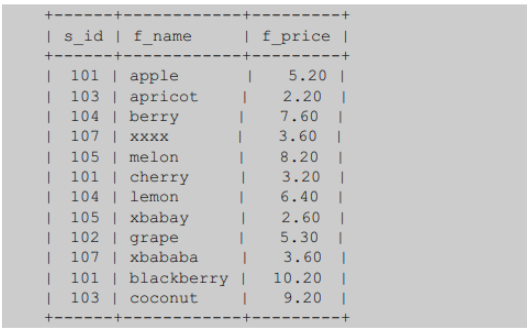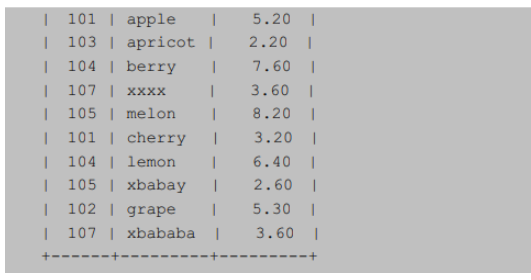How to merge query results in MySQL
Multiple SELECT statements can be combined into a single result set through the UNION keyword. When merging, the number of columns and data types corresponding to the two tables must be the same. Separate SELECT statements using the UNION or UNION ALL keyword. UNION does not use the keyword ALL, and duplicate records are deleted during execution, and all returned rows are unique; the function of using the keyword ALL is not to delete duplicate rows and not to automatically sort the results. The basic syntax format is as follows:
SELECT column,... FROM table1 UNION [ALL] SELECT column,... FROM table2
Query the information of all fruits with a price less than 9, query the information of all fruits with s_id equal to 101 and 103, use UNION to connect the query results, the SQL statement is as follows:
SELECT s_id, f_name, f_price FROM fruits WHERE f_price < 9.0 UNION SELECT s_id, f_name, f_price FROM fruits WHERE s_id IN(101,103);
The combined query results are as follows:

UNION combines the results of multiple SELECT statements into a single result set, as mentioned previously.. You can view the results of each SELECT statement separately:
SELECT s_id, f_name, f_price FROM fruits WHERE f_price < 9.0;

SELECT s_id, f_name, f_price FROM fruits WHERE s_id IN(101,103);

You can see from the results of separate queries that the first SELECT statement To query the fruits whose price is less than 9, the second SELECT statement queries the fruits provided by suppliers 101 and 103. Use UNION to separate two SELECT statements. After execution, combine the output results into a single result set and delete duplicate records.
In the previous example, due to the use of UNION ALL to contain duplicate rows, the same records were generated when querying separately. UNION automatically removes duplicate rows from the query result set. If you want to return all matching rows without deletion, you can use UNION ALL.
Query the information of all fruits with a price less than 9, query the information of all fruits with s_id equal to 101 and 103, use UNION ALL to connect the query results, the SQL statement is as follows:
SELECT s_id, f_name, f_price FROM fruits WHERE f_price < 9.0 UNION ALL SELECT s_id, f_name, f_price FROM fruits WHERE s_id IN(101,103);
The query results are as follows:

As you can see from the results, the total number of records here is equal to the sum of the number of records returned by the two SELECT statements. The connection query results do not remove duplicate rows.
Tip: The difference between UNION and UNION ALL: The function of using UNION ALL is not to delete duplicate rows, plus the ALL keyword statement requires less resources when executing, so use it as much as possible. Therefore, when you know that there are duplicate rows but want to keep these rows, and make sure that there will be no duplicate data in the query results or there is no need to remove duplicate data, you should use UNION ALL to improve query efficiency.
The above is the detailed content of How to merge query results in MySQL. For more information, please follow other related articles on the PHP Chinese website!

Hot AI Tools

Undresser.AI Undress
AI-powered app for creating realistic nude photos

AI Clothes Remover
Online AI tool for removing clothes from photos.

Undress AI Tool
Undress images for free

Clothoff.io
AI clothes remover

AI Hentai Generator
Generate AI Hentai for free.

Hot Article

Hot Tools

Notepad++7.3.1
Easy-to-use and free code editor

SublimeText3 Chinese version
Chinese version, very easy to use

Zend Studio 13.0.1
Powerful PHP integrated development environment

Dreamweaver CS6
Visual web development tools

SublimeText3 Mac version
God-level code editing software (SublimeText3)

Hot Topics
 PHP's big data structure processing skills
May 08, 2024 am 10:24 AM
PHP's big data structure processing skills
May 08, 2024 am 10:24 AM
Big data structure processing skills: Chunking: Break down the data set and process it in chunks to reduce memory consumption. Generator: Generate data items one by one without loading the entire data set, suitable for unlimited data sets. Streaming: Read files or query results line by line, suitable for large files or remote data. External storage: For very large data sets, store the data in a database or NoSQL.
 How to optimize MySQL query performance in PHP?
Jun 03, 2024 pm 08:11 PM
How to optimize MySQL query performance in PHP?
Jun 03, 2024 pm 08:11 PM
MySQL query performance can be optimized by building indexes that reduce lookup time from linear complexity to logarithmic complexity. Use PreparedStatements to prevent SQL injection and improve query performance. Limit query results and reduce the amount of data processed by the server. Optimize join queries, including using appropriate join types, creating indexes, and considering using subqueries. Analyze queries to identify bottlenecks; use caching to reduce database load; optimize PHP code to minimize overhead.
 How to use MySQL backup and restore in PHP?
Jun 03, 2024 pm 12:19 PM
How to use MySQL backup and restore in PHP?
Jun 03, 2024 pm 12:19 PM
Backing up and restoring a MySQL database in PHP can be achieved by following these steps: Back up the database: Use the mysqldump command to dump the database into a SQL file. Restore database: Use the mysql command to restore the database from SQL files.
 How to insert data into a MySQL table using PHP?
Jun 02, 2024 pm 02:26 PM
How to insert data into a MySQL table using PHP?
Jun 02, 2024 pm 02:26 PM
How to insert data into MySQL table? Connect to the database: Use mysqli to establish a connection to the database. Prepare the SQL query: Write an INSERT statement to specify the columns and values to be inserted. Execute query: Use the query() method to execute the insertion query. If successful, a confirmation message will be output.
 How to fix mysql_native_password not loaded errors on MySQL 8.4
Dec 09, 2024 am 11:42 AM
How to fix mysql_native_password not loaded errors on MySQL 8.4
Dec 09, 2024 am 11:42 AM
One of the major changes introduced in MySQL 8.4 (the latest LTS release as of 2024) is that the "MySQL Native Password" plugin is no longer enabled by default. Further, MySQL 9.0 removes this plugin completely. This change affects PHP and other app
 How to use MySQL stored procedures in PHP?
Jun 02, 2024 pm 02:13 PM
How to use MySQL stored procedures in PHP?
Jun 02, 2024 pm 02:13 PM
To use MySQL stored procedures in PHP: Use PDO or the MySQLi extension to connect to a MySQL database. Prepare the statement to call the stored procedure. Execute the stored procedure. Process the result set (if the stored procedure returns results). Close the database connection.
 How to create a MySQL table using PHP?
Jun 04, 2024 pm 01:57 PM
How to create a MySQL table using PHP?
Jun 04, 2024 pm 01:57 PM
Creating a MySQL table using PHP requires the following steps: Connect to the database. Create the database if it does not exist. Select a database. Create table. Execute the query. Close the connection.
 The difference between oracle database and mysql
May 10, 2024 am 01:54 AM
The difference between oracle database and mysql
May 10, 2024 am 01:54 AM
Oracle database and MySQL are both databases based on the relational model, but Oracle is superior in terms of compatibility, scalability, data types and security; while MySQL focuses on speed and flexibility and is more suitable for small to medium-sized data sets. . ① Oracle provides a wide range of data types, ② provides advanced security features, ③ is suitable for enterprise-level applications; ① MySQL supports NoSQL data types, ② has fewer security measures, and ③ is suitable for small to medium-sized applications.






